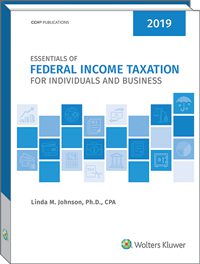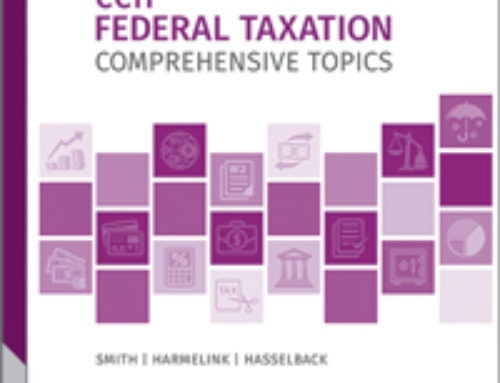Essentials of Federal Income Taxation for Individuals and Business (2019) by Linda M. Johnson features an easy-reading, straightforward forms approach that is both simple and direct without complex legal language. It introduces basic tax concepts and then fully illustrates them with clear examples and helpful filled-in forms. Organized to save time, Essentials of Federal Income Taxation builds a firm foundation on which to build students’ knowledge and understanding of the tax issues which will affect them throughout their careers.
- Topics and Content
- Overview of the Tax Structure
- Tax Determination, Payments and Reporting Procedures
- Gross Income Inclusions
- Gross Income Exclusions and Deductions for AGI
- Personal Itemized Deductions
- Other Itemized Deductions
- Self-Employment
- Depreciation and Amortization
- Rental Activities
- Property: Basis and Nontaxable Exchanges
- Property: Capital Gains and Losses, and Depreciation Recapture
- NOLs, AMT, and Business Tax Credits
- Withholding, Payroll, and Estimated Taxes
- C Corporations
- Partnerships and S Corporations
ISBN: 9780808050476
chapter 1 quiz
Question 1
When a married person files a joint return, that person can never be claimed as a dependent by another taxpayer.
True
False✓
Question 2
Under the Multiple Support Agreement rules, any taxpayer who provides more than 10% of the support of another person qualifies to claim that person as a dependent.
True
False✓
Question 3
A married couple filing jointly can increase their standard deduction by $5,000 if both are elderly and blind.
True
False✓
Question 4
A widow with a dependent child uses the married filing jointly filing status for the two years immediately after the year of the spouse’s death.
True
False✓
Question 5
Abe and Tammy divorced in 2009. Abe continues to support Tammy’s mother, who lives in a nursing home. Abe cannot claim his mother-in-law as a dependent because she no longer passes the relationship test.
True
False✓
Question 6
Which of the following can be deducted as an itemized deduction on an individual taxpayer’s tax return?
- Medical expenses
- Casualty losses
- Employee business expenses
- None of the above can be deducted as an itemized deduction
- All of the above can be deducted as an itemized deduction✓
Question 7
Carol is 20 years old and single. Her parents properly claim her as a dependent on their joint tax return. During 2017, Carol had the following income and expense items:
Wages from a part-time summer job $3,000
Interest income from her own savings account 2,500
State and local income taxes paid 800
State and local sales tax paid 200
Carol’s 2017 taxable income is:
$0.
$2,150.✓
$4,450.
$1,950.
$1,750.
Question 8
The minimum percentage of support that a member of a multiple support group must provide to claim the supported person as a dependent is more than:
10%. ✓
15%.
20%.
25%.
None of the above.
Question 9
Tammy (unmarried, age 56) claims her elderly mother (age 74) as a dependent. Tammy’s mother does not live with her, but Tammy pays for almost all of the costs of maintaining her mother’s household. Tammy’s 2018 standard deduction is:
$18,000. ✓
$10,900.
$6,350.
$7,900.
$10,600.
Question 10
Frank celebrates his 65th birthday on January 1, 2019. Frank lives with his wife, Mary, who is 66 years of age. Neither Frank nor Mary is blind. On their joint tax return for 2018, Frank and Mary claim a standard deduction of:
$26,600. ✓
$2,650.
$18,000.
$9350.
chapter 2 quiz
1. Married filing jointly and qualifying widow(er) share the same tax rates.
True ✓
False
2. Taxpayers with taxable income of less than $100,000 must use the Tax Table to determine their tax liability.
True ✓
False
3. To qualify for the earned income credit, the taxpayer must maintain a home for at least one qualifying child.
True
False ✓
4. The amount of the earned income credit is computed by looking up the credit on both the taxpayer’s earned income and adjusted gross income and taking the lesser of the two amounts.
True ✓
False
5. Which of the following is a refundable credit?
The lifetime learning education credit
The retirement savings contributions credit
The premium tax credit ✓
The child and dependent care credit
None of the above is refundable credits
6. Which of the following statements is not correct regarding the education credit?
The lifetime learning credit is 100% nonrefundable.
Lower AGI thresholds apply to reduce the American opportunity credit for higher income taxpayers. ✓
The lifetime learning credit is available to students who attend graduate school.
The maximum American opportunity credit is $2,500 for each eligible student.
All of the above statements are correct.
7. The tax liability on $50,000 of taxable income would be the same if computed using the tax rate schedule and the tax table.
True
False ✓
8. Taxpayers with AGI in excess of $250,000 are not entitled to the child and dependent care credit.
True
False ✓
9. A dependent physically unable to provide self-care is a qualifying person for purposes of the child and dependent care credit, regardless of the dependent’s age.
True ✓
False
10. For purposes of the child and dependent care credit, a spouse who does not work but attends college full-time for 9 months during the year is deemed to earn $2,500 if he and his wife have one qualifying person.
True
False ✓
11. The IRS presents the tax rates to individual taxpayers in the form of Tax Rate Schedules and a Tax Table. Taxpayers who use the Tax Table to compute their tax will find that for an equal amount of taxable income their tax will always:
equal the tax determined from using the Tax Rate Schedule for the proper filing status.
be larger than the tax determined from using the Tax Rate Schedule for the proper filing status.
be smaller than the tax determined from using the Tax Rate Schedule for the proper filing status.
equal or be within a few dollars of the tax determined from using the Tax Rate Schedule for the proper filing status. ✓
always be different from the tax determined using the Tax Rate Schedule for the proper filing status.
12. Which of the following credits may be carried over if not entirely utilized in the current year?
Child tax credit
Child and dependent care credit
Adoption credit ✓
Earned income credit
Premium tax credit
13. Employees who work for two employers may have too much in OASDI taxes withheld from their gross wages. To have too much in OASDI taxes withheld from their pay in 2017, employees’ gross wages would have to exceed:
$200,000.
$128,400. ✓
$250,000.
$125,000.
$127,200.
14. For tuition expenses paid during the year for a student attending graduate school, an education credit is available that is equal to:
100% of up to $2,500 of such expenses.
20% of up to $2,500 of such expenses.
20% of up to $10,000 of such expenses. ✓
50% of up to $10,000 of such expenses.
$2,000 plus 25% of the next $2,000 of such expenses.


Leave A Comment